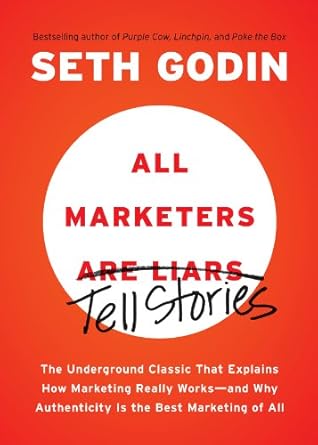More on this book
Community
Kindle Notes & Highlights
by
Seth Godin
Read between
April 21 - May 8, 2019
You don’t get to just sit down and make up a story and expect that people will believe it merely because you want them to. Consumers are too clever for that.
This is where the art of marketing occurs. For most products and services, skywriting, billboards and telemarketing are precisely the wrong ways to spread a message. Not because they won’t be noticed—they probably will. But because they won’t be believed. In order to be believed, you must present enough of a change that the consumer chooses to notice it. But then you have to tell a story, not give a lecture. You have to hint at the facts, not announce them. You cannot prove your way into a sale—you gain a customer when the customer proves to herself that you’re a good choice. The process of
...more
Expectations are the engine of our perceptions. And complex stories carry all sorts of perceptions. Where people choose to shop, the way the transaction is handled, the noise, the music, the lighting—each element is at least as important as the item itself.
Storytelling works when the story actually makes the product or service better.
Marketers are wrong when they insist that “all we do is offer options—it’s up to consumers to decide for themselves.” Marketing is now so well developed and so embedded in our culture that consumers no longer make decisions based on a rational analysis of facts. Instead they decide based on the stories they’re told. To disclaim responsibility for a fraud is cowardly.
if you want to grow, make something worth talking about.
The story is part of the product or service that they buy—in many cases, the story is what people set out to buy. But at the core of a story is the thing, the real thing, the essence of what you’ve built. And if you try to build on a rotten core, you’ll succeed for a bit but then you’ll lose.
The good news is clear: authentic marketing, from one human to another, is extremely powerful. Telling a story authentically, creating a product or service that actually does what you say it will leads to a different sort of endgame. The marketer wins and so do her customers. A story that works combined with authenticity and minimized side effects builds a brand (and a business) for the ages.
once fooled, a person will never repeat your story to someone else.
Some senses count for more than others, but every sense matters.
IT’S THE COMBINATION OF SENSES THAT NOW CONVINCES THE SKEPTICAL CONSUMER
The problem is that once a consumer has bought someone else’s story and believes that lie, persuading the consumer to switch is the same as persuading him to admit he was wrong. And people hate admitting that they’re wrong.
The best strategy would have been to go first. Failing that, the appropriate response would have to been to tell a completely different story, one that used a frame that matched the worldview of the undecided voter.
You succeed by being an extremist in your storytelling, then gracefully moving your product or service to the middle so it becomes more palatable to audiences that are persuaded by their friends, not by you.
Your goal should not (must not) be to create a story that is quick, involves no risks and is without controversy. Boredom will not help you grow.
It’s hard to be remarkable when you and your organization insist on not changing the status quo.
Using the soap itself is nothing but a reminder of the way you felt (good) when you told yourself a story while buying the soap in the first place. Ready for this? The product is nothing but a souvenir of your trip to the store—and a reminder of the way you felt when you bought it.
Cheap is not marketing.
Remember, the marketer tells a story. The consumer believes it and it becomes a lie. And that lie can spread from person to person. Then and only then is the marketer going to succeed and will sales grow.
old stories die hard.


